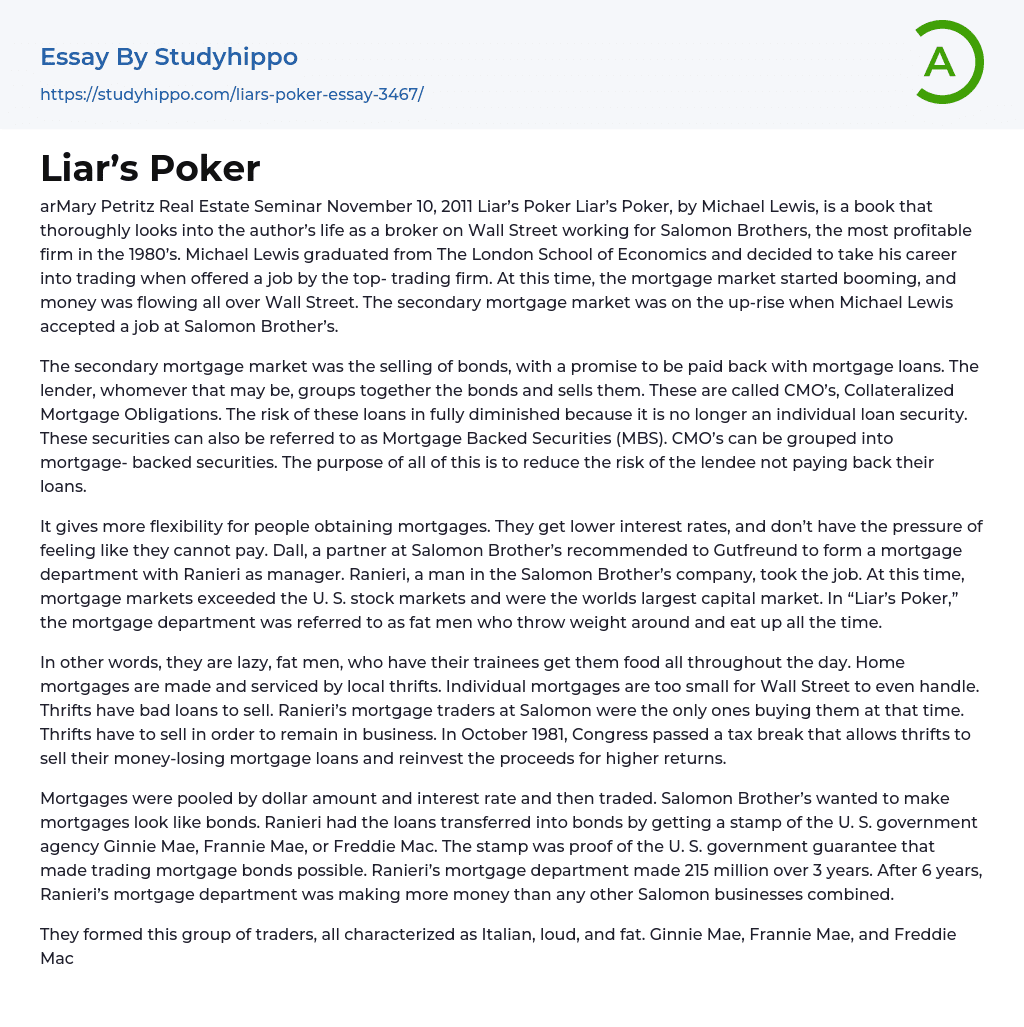The secondary mortgage market was the selling of bonds, with a promise to be paid back with mortgage loans. The lender, whomever that may be, groups together the bonds and sells them. These are called CMO’s, Collateralized Mortgage Obligations. The risk of these loans in fully diminished because it is no longer an individual loan security. These securities can also be referred to as Mortgage Backed Securities. CMO’s can be grouped into mortgage- backed securities. The purpose of all of this is to reduce the risk of the lendee not paying back their loans.
It gives more flexibility for people obtaining mortgages. They get lower interest rates, and don’t have the pressure of feeling like they cannot pay. Dall, a partner at Salomon Brother’s recommended to Gutfreund to form a mortgage department with Ranieri as man
...ager. Ranieri, a man in the Salomon Brother’s company, took the job. At this time, mortgage markets exceeded the U. S. stock markets and were the worlds largest capital market. In “Liar’s Poker,” the mortgage department was referred to as fat men who throw weight around and eat up all the time.
In other words, they are lazy, fat men, who have their trainees get them food all throughout the day. Home mortgages are made and serviced by local thrifts. Individual mortgages are too small for Wall Street to even handle. Thrifts have bad loans to sell. Ranieri’s mortgage traders at Salomon were the only ones buying them at that time. Thrifts have to sell in order to remain in business. In October 1981, Congress passed a tax break that allows thrifts to sell their money-losing mortgage loans and reinvest the proceeds
for higher returns.
Mortgages were pooled by dollar amount and interest rate and then traded. Salomon Brother’s wanted to make mortgages look like bonds. Ranieri had the loans transferred into bonds by getting a stamp of the U. S. government agency Ginnie Mae, Frannie Mae, or Freddie Mac. The stamp was proof of the U. S. government guarantee that made trading mortgage bonds possible. Ranieri’s mortgage department made 215 million over 3 years. After 6 years, Ranieri’s mortgage department was making more money than any other Salomon businesses combined.
They formed this group of traders, all characterized as Italian, loud, and fat. Ginnie Mae, Frannie Mae, and Freddie Mac were U. S. government agencies that guaranteed various types of mortgage loans. They allowed mortgage lenders to obtain a better price for their mortgage loans in the securities market. Lenders used the proceeds to make new mortgage loans available. After some time, and with the mortgage market soaring, buyers and sellers were making their own rules. Salomon Brother’s created a CMO in 1983, which dominated the mortgage market in 1986.
The mortgage market was attractive to many investors due to the money outflow that it generated. It was unattractive to some investors due to the stress, competition, and buying of the thrifts that most companies did not want to do, except Salomon Brother’s. In the 1980’s, the bond market also boomed. The Federal Reserve created a fixed money supply that let interest rates float. It was an inverse relationship with bonds; the value of fixed interest rate bonds would increase or decrease opposite of the interest rates.
The change in the interest rates resulted in a gain or loss for
the market. The fixed money supply allowed more control over interest rates, which enabled traders to have more control over what they were trading and for how much. The training program at Salomon Brother’s supported the myth that “a great trader is a great savage among trader-savages. ” While the bond market was booming, the equity department had its downfalls. The fixed stock commissions ended in 1975, which resulted in the fortunes of the equity department deteriorating.
The equity market makes money competing with stockbrokers, while the bond market, Salomon’s to be specific, monopolizes markets. Equity people have less money, but more contentment. Bond people have more money but less contentment. The equity market relies on experience, and not formulas or theories. In “Liar’s Poker,” the bond traders were the fastest-growing group of borrowers in the late 1970s, early 1980s. Due to the ending of the fixed stock commission, bond traders diminished in value. Michael Lewis ended up being the highest paid trainee at Salomon Brother’s and did very well for him self.
Salomon Brother’s crashed due to economic downturn, and other companies achieving skills in the mortgage, equity, and bond markets. Management was lack, and many of the high-end employees left for other companies. “Liar’s Poker” discusses the rise and fall of the secondary mortgage market, and how people and companies struggled with it. Salomon Brother’s went from being the top trading company on Wall Street, to being bought out. “Liar’s Poker” displays in great detail how the mortgage market came about, and how Wall Street played the game.
- Commercial Bank essays
- Debit Card essays
- Deposit Account essays
- Subprime Lending essays
- Futures Contract essays
- Mortgage Loan essays
- Renting essays
- Transaction Cost essays
- Bank essays
- Banking essays
- Corporate Finance essays
- Credit Card essays
- Currency essays
- Debt essays
- Donation essays
- Enron Scandal essays
- Equity essays
- Financial Accounting essays
- Financial Crisis essays
- Financial News essays
- Financial Ratios essays
- Financial Services essays
- Forecasting essays
- Foreign Exchange Market essays
- Free Market essays
- Gold essays
- Investment essays
- Legacy essays
- Loan essays
- Market Segmentation essays
- Money essays
- Personal finance essays
- Purchasing essays
- Retirement essays
- Shareholder essays
- Stock Market essays
- Supply And Demand essays
- Venture Capital essays
- Buying Homes essays




